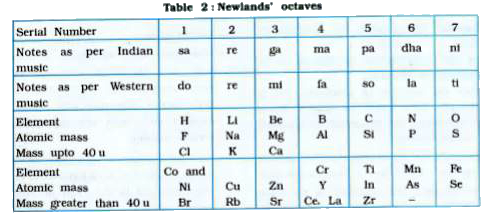Explain the Newlands' law of octaves.
Text Solution
The attempts of Dobereiner encouraged other chemists to correlate the properties of elements with their atomic masses.
In 1866, John Newlands, an English scientist, arranged the then known elements in the order of increasing atomic masses.
He started with hydrogen, the element having the lowest atomic mass and ended at thorium which was the 56th element.
Newlands found that every eighth element had properties similar to the properties of the first element.
Newlands observe this analogy with the octaves found in musical scale and proposed the law of octaves which is given as below:
Law of octaves : "When elements are arranged in order of their increasing atomic masses, then the properties of every eighth element are similar to the properties of the first element."
A part of the original form of Newlands. octaves is given below in Table 2.

In Newlands. octaves, the propeties of lithium and sodium are same. Sodium is the eighth element after lithium. Similarly. beryllium and magnesium possess similar properties.
|
Topper's Solved these Questions
- PERIODIC CLASSIFICATION OF ELEMENTSBOOK - KUMAR PRAKASHANCHAPTER - PERIODIC CLASSIFICATION OF ELEMENTSEXERCISE - TEXTUAL EXERCISE
13 Videos
- PERIODIC CLASSIFICATION OF ELEMENTSBOOK - KUMAR PRAKASHANCHAPTER - PERIODIC CLASSIFICATION OF ELEMENTSEXERCISE - ADDITIONAL QUESTIONS AND ANSWER ( Answer the following questions in short:)
8 Videos
- MODEL QUESTION PAPER 01BOOK - KUMAR PRAKASHANCHAPTER - MODEL QUESTION PAPER 01EXERCISE - (SECTION-A) (MCQs)
1 Videos
- QUESTION PAPER-2 (MARCH,2020 - BOARD'S QUESTIONS PAPER)BOOK - KUMAR PRAKASHANCHAPTER - QUESTION PAPER-2 (MARCH,2020 - BOARD'S QUESTIONS PAPER)EXERCISE - Section - D (Answer the following questions)
3 Videos
Similar Questions
Knowledge Check
The discovery of which of the following group of element gave death to the Newland law of octave?
AInert gasBAlkaline earth metalCRare earthDActinoid series
State and explain Newlands' law of octaves .
View SolutionWhat is meant by Newlands law of octaves?
View SolutionWhat were the limitations of Newlands’ Law of Octaves?
View SolutionWhich one of the following elements posed a challenge to Newlands 's law of octaves ?
Li,Be,B,C,N,O,F,Ne,Na
View SolutionWhat is meant by Newlands law of octaves?
View SolutionFor which elements, Newlands' law of octaves is not applicable?
View SolutionX and Y are the two elements having similar properties which obey Newland's law of octaves. How many elements are there in between X and Y?
View Solution
